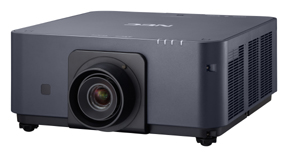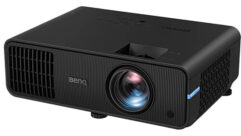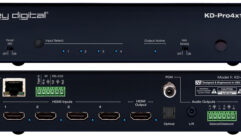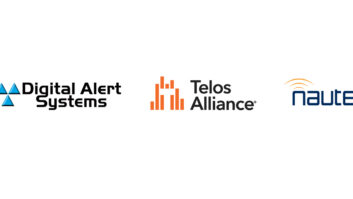
SVC Podcast – Show Notes – Show 127-2:
In this edition of the SVC Podcast, SVC Contributing Editor Bennett Liles wraps up his talk with Richard McPherson, Senior Product Manager for Projectors with NEC Display Solutions about lampless projector technology. He explains what projector manufacturers are doing to help prospective buyers sort through the types of lampless projection technology and figure their cost of ownership. Richard also reminds listeners that a poor ambient light environment will compromise the display quality of any type of projection system.
Links of interest:
- NEC Display Solutions
- The NEC NC1100L-A for theaters with small screens
- The 6000 lumen laser-phosphor NEC PX602UL
Download Podcast Here:
https://s3.amazonaws.com/nb-svc/public/public/127-2_Lampless_Projectors_…
From Sound & Video Contractor Magazine, this is the SVC Podcast with Richard McPherson of NEC Display Solutions. Show notes for the podcast are available on the web site of Sound & Video Contractor Magazine at svconline.com.
Lampless projection seems as though it’s finally ready for prime time with ten thousand lumen models available, but what type should you invest in? Richard McPherson, Senior Product Manager for Projectors with NEC Display Solutions is here to guide us through the specs and the technology behind lamp-free projection. That’s coming right up on the SVC Podcast.
Richard, thanks for being back with us for Part 2 on the SVC Podcast talking about lampless projectors and what better guy to talk to about this than the Senior Product Manager for Projectors with NEC? In Part 1, we got into the different types of lampless projectors with LED, laser, laser phosphor and the color response and other specs. I know there are always tricks of the trade in marketing any kind of AV hardware so are manufacturers doing anything now to make it easier to choose between lamp-free and lamped models?
Yeah, thanks for having me address that. Manufacturers are looking at it from a multitude of ways. So when we look at just the TCO calculation, of course we are comparing like products. When we refer to like products – cabinet size, market, brightness – we try to look at that in our own lineup, not necessarily across competitive lineups. But in our own lineup we look at our own models and compare TCO values to laser modules or laser phosphor modules or the LED modules to the lamp projectors themselves. That gives the customer a better understanding of what they’re actually buying as they’re going into the lampless system and there’s so many factors that come into play. Some companies or customers simply want to look at well, if I don’t have to replace a lamp then that’s just a cost that I have to deal with. Well, it’s not as simple as that. It goes back to the fact that not only is it the maintenance cost of replacing the lamp, but it’s always how do we provide a way to get to the projector to replace the lamp. That’s time and money. It’s also the fact that – and I mentioned it in the previous podcast – when we look at the lamp life itself versus the laser life itself or the lampless system itself, you’re comparing the brightness decrease, one technology to the other, you absolutely see the fact that you’re not going to see the light drop off the lampless system versus the lamp-based system. So the longevity in that regard isn’t something that you can put monetarily in a customer’s pocket. You have to explain it so they understand what you’re doing. So that’s just a different way that we’re looking at it from a TCO standpoint. The other way would be with the fact that we are looking at, and we have addressed certain areas where we extend the warranty of the projector as well as the lampless module so that the customers feel more at ease with the fact that yes, you’re paying a little bit more, but they have a longer warranty for the product itself. [Timestamp: 3:18]
And it may be important to note here that you can get pretty involved in the technology between lamped and lamp-free projectors but at a basic point, if you have a poor lighting situation in the projection environment, no system is going to look very good.
That’s correct. I mean it really comes down to what you’re trying to do. So if you look at the environment itself, both from an ambient lighting standpoint as well as screen size, it all comes into play. So as you increase the ambient light in the room you have to increase the horsepower from the projector itself. You need to have more light on the screen to compensate for the ambient lighting conditions. If you can control the lights then you can get away with having a slightly lower brightness of projector. The other avenue that comes into play is screen gain. So you can have a simple 1.0 gain screen, which isn’t going to increase the brightness of the projector itself, but if you can get it to 1.5 or potentially 2.0, depending on the environment, you’re going to be able to increase the image coming off the screen yet not have to worry about increasing your light output the projector. The downside to that is the offset angle or offset viewing angle of the screen itself, so a higher gain screen you have a narrower room, but there’s ways to compensate either way. But yeah, when we’re looking at the brightness, it really comes into play as to what the ambient lighting condition is going to be. [Timestamp: 4:38]
And of course minimizing, as you can, the distance between the projector and the screen helps. So are there maintenance or installation issues that apply specifically to lampless projectors that you don’t have with lamped models?
Currently, the only one that really comes into mind is the fact that until – we’re looking at anything that’s laser-based systems, so the LED projectors we don’t have to worry and depending on the category, the laser system itself, we don’t have any worries. So if it’s a Class 1 or Class 2 in today’s world – and moving forward regulations will change and most will be Class 1 – but when you look at those systems that are higher brightness there’s still regulations that have to be kind of sifted through and created by the FDA in order for us to potentially do that service in the field or at a service center. So currently, our plan right now is to have projectors come back to NEC for service when we’re looking at the 6,000 lumen and above category just because we don’t know what the regulations are going to change to when we look at a maintenance standpoint from the FDA side of things. It’s a laser-based system, so we have to be careful as to what the FDA’s going to allow us to do. That’s a statement from NEC, but realistically that’s a statement to ask the – that’s kind of spread across the industry, I do believe. I’m not going to state anything further for manufacturers, but that’s my belief. [Timestamp: 5:59]
You’re always dealing with the bottom line, especially in the education environment where you have tight budgets and large AV system deployments. You can spend a couple of thousand bucks and get a 5,000-lumen projector but how long is it going to be before we can say that about lampless projectors?
That’s a tough one for me to answer at this moment, only because currently other than our LED-based model, the only thing that we currently have is the 6,000-lumen projector. So I can’t really state as to that model would be able to achieve that only because that’s designed for it to fit into a product category all together. It’s a different feature set than anything that would be in that 5,000-lumen brightness range. So NEC, as of right now, only has that 6,000-lumen but in the future who knows what we’ll come out with and how we’ll handle that from a pricing standpoint. You know, as technology changes, as technology increases, as volume of production increases because customers are buying more products, lampless-based technology will come down in price, as in fact that happens with everything in technology. So we anticipate that that’s going to happen. To start with, yes it’s going to be a little bit pricier, but in due time it’s going to come down in price. [Timestamp: 7:14]
And I guess that along with coming down in price, the feature set will expand. So if you want to integrate something like HDBaseT natively into the projector, what would that add to the cost?
That’s a good question. I’m going to kind of skirt around what the cost would add to it because for NEC we’re adding that in a lot of our lamp-based systems that are 5,000-lumen and above. So when we’re looking at that category we’re automatically adding the HDBaseT connections. We’re adding a multitude of different connections such as wireless technologies, so it’s not a matter of being lamp-based or lampless as much as it is what feature set is required for the installation type of projector. So there’s obviously an added cost, but it’s not so drastic that it would prevent customers from wanting to purchase that projector or put it out of the price range of those specific customers. [Timestamp: 8:08]
Yeah, I think that if it’s a situation where they really need it they’re just going to demand it and pay for it.
And rightfully so because when you’re looking at something such as HDBaseT, the technology lends great to the customer, right? And so when you look at the fact that you have one single cable transmitting audio, video, control and some PoE over the connection, it’s a no-brainer, right, when we’re comparing that to all the different video cables that would have to be connected. So from an infrastructure standpoint it’s a great connector to have on your product and so NEC is doing that moving forward. [Timestamp: 8:44]
Now that these devices have found their way into projectors along with the prices coming down, they’re going to find their way into a lot of other devices. So what do you think about solid-state imaging of increasing power getting into smart phones, tablets and other gadgets and being able to project even from those?
NEC doesn’t have anything now and I haven’t seen anything to date, but we do know that there’s micro projectors on the market, you know, the little portable ones that can create a 27-inch screen, walk in, setting it on a desk to create around a 27- to 30-inch screen, and that we have something up on the wall that you can talk to. Will that, in turn, be inserted or included into a smart phone or a tablet? I would venture a guess that it’s a possibility. I don’t personally know of anything that’s being developed right now, so I can’t completely give you an answer, but I would imagine since the technologies are kind of emerging you can see that the little projectors and the micro projectors are getting smaller and smaller and a little bit brighter that the possibility exists. [Timestamp: 9:46]
Well it will depend on market forces, but the possibilities are certainly endless. It’s really exciting to talk about lampless projector technology because a lot of us are right on the edge of deciding if we’re ready to go with that. It’s been great listening to this and I appreciate you’re being here to give us the latest. Richard McPherson, Senior Product Manager for Projectors at NEC Display Solutions. Lots going on with lampless projectors.
Yes. Thank you very much for your time, Bennett. I appreciate it.
Thank you for being here with us for the SVC Podcast with Richard McPherson. Show notes are available on the website of Sound & Video Contractor Magazine at svconline.com. Be with us again next time for the SVC Podcast.










